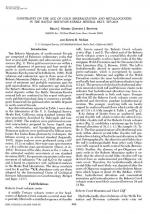Добрый день, Коллеги. Важное сообщение, просьба принять участие. Музей Ферсмана ищет помощь для реставрационных работ в помещении. Подробности по ссылке
Constraints on the age of gold mineralization and metallogenesis in the Battle Mountain-Eureka mineral belt, Nevada
The Roberts Mountains of north-central Nevada are comprised of Paleozoic sedimentary rocks that host several gold deposits and subeconomic gold resources (Fig. 1). These gold occurrences are within a regional alignment of precious and base metal deposits in north-central Nevada termed the Battle Mountain-Eureka mineral belt (Roberts, 1966). Field relations and radiometric ages in three areas of the Roberts Mountains (Maher et al., 1990) allow assignment of minimum and probable maximum ages for gold mineralization. New radiometric age data from the Roberts Mountains and other precious and base metal deposits within the Battle Mountain-Eureka mineral belt are combined in this report with previously published geologic data to construct a metallo-genic framework for gold and other metallic deposits in north-central Nevada.
Age determinations reported in Table 1 were done in the laboratories of the U. S. Geological Survey, Menlo Park, California, using standard isotope dilution procedures described by Dalrymple and Lan-phere (1969). The analyses were performed on mineral concentrates prepared by heavy liquid, magnetic, electrostatic, and handpicking procedures. Potassium analyses were performed by lithium meta-borate flux fusion-flame photometry techniques, the lithium serving as an internal standard (Ingamells, 1970). Argon analyses were performed using a 60° sector, 15.2-cm radius, Nier-type mass spectrometer or a five-collector mass spectrometer (Stacey et al., 1981). Precision of the data, shown as the ± value, is the estimated analytic uncertainty at one standard deviation (68%). It represents uncertainty in the measurement of radiogenic 40Ar and K20 in the sample and is based on experience with replicated analyses in the Menlo Park laboratories. The decay constants used for K and the 40K/K abundance ratio are those adopted by the International Union of Geological Sciences Subcommission on Geochronology (Steiger and Jager, 1977).




